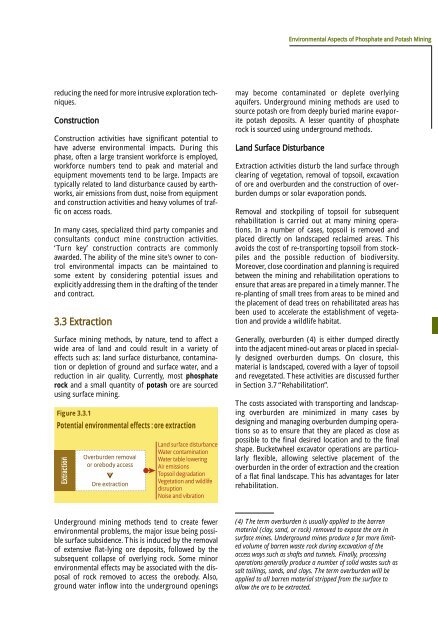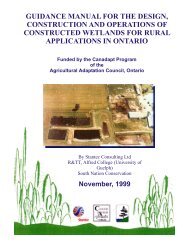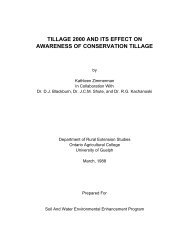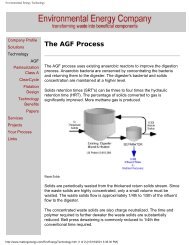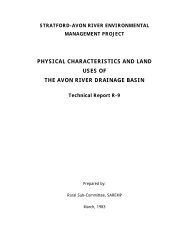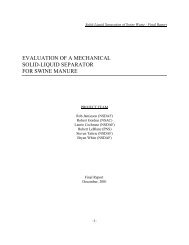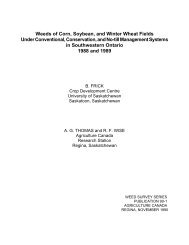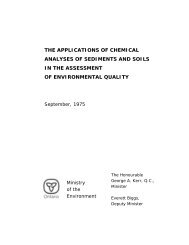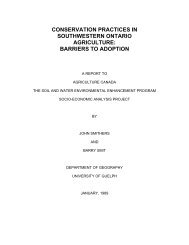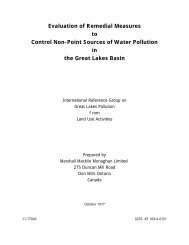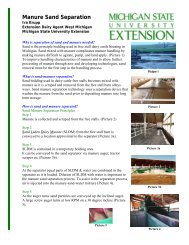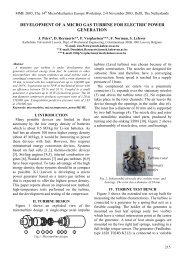Environmental Aspects of Phosphate and Potash Mining United ...
Environmental Aspects of Phosphate and Potash Mining United ...
Environmental Aspects of Phosphate and Potash Mining United ...
You also want an ePaper? Increase the reach of your titles
YUMPU automatically turns print PDFs into web optimized ePapers that Google loves.
Extraction<br />
<strong>Environmental</strong> <strong>Aspects</strong> <strong>of</strong> <strong>Phosphate</strong> <strong>and</strong> <strong>Potash</strong> <strong>Mining</strong><br />
reducing the need for more intrusive exploration techniques.<br />
Construction<br />
Construction activities have significant potential to<br />
have adverse environmental impacts. During this<br />
phase, <strong>of</strong>ten a large transient workforce is employed,<br />
workforce numbers tend to peak <strong>and</strong> material <strong>and</strong><br />
equipment movements tend to be large. Impacts are<br />
typically related to l<strong>and</strong> disturbance caused by earthworks,<br />
air emissions from dust, noise from equipment<br />
<strong>and</strong> construction activities <strong>and</strong> heavy volumes <strong>of</strong> traffic<br />
on access roads.<br />
In many cases, specialized third party companies <strong>and</strong><br />
consultants conduct mine construction activities.<br />
‘Turn key’ construction contracts are commonly<br />
awarded. The ability <strong>of</strong> the mine site's owner to control<br />
environmental impacts can be maintained to<br />
some extent by considering potential issues <strong>and</strong><br />
explicitly addressing them in the drafting <strong>of</strong> the tender<br />
<strong>and</strong> contract.<br />
3.3 Extraction<br />
Surface mining methods, by nature, tend to affect a<br />
wide area <strong>of</strong> l<strong>and</strong> <strong>and</strong> could result in a variety <strong>of</strong><br />
effects such as: l<strong>and</strong> surface disturbance, contamination<br />
or depletion <strong>of</strong> ground <strong>and</strong> surface water, <strong>and</strong> a<br />
reduction in air quality. Currently, most phosphate<br />
rock <strong>and</strong> a small quantity <strong>of</strong> potash ore are sourced<br />
using surface mining.<br />
Figure 3.3.1<br />
Potential environmental effects : ore extraction<br />
Overburden removal<br />
or orebody access<br />
Ore extraction<br />
L<strong>and</strong> surface disturbance<br />
Water contamination<br />
Water table lowering<br />
Air emissions<br />
Topsoil degradation<br />
Vegetation <strong>and</strong> wildlife<br />
disruption<br />
Noise <strong>and</strong> vibration<br />
may become contaminated or deplete overlying<br />
aquifers. Underground mining methods are used to<br />
source potash ore from deeply buried marine evaporite<br />
potash deposits. A lesser quantity <strong>of</strong> phosphate<br />
rock is sourced using underground methods.<br />
L<strong>and</strong> Surface Disturbance<br />
Extraction activities disturb the l<strong>and</strong> surface through<br />
clearing <strong>of</strong> vegetation, removal <strong>of</strong> topsoil, excavation<br />
<strong>of</strong> ore <strong>and</strong> overburden <strong>and</strong> the construction <strong>of</strong> overburden<br />
dumps or solar evaporation ponds.<br />
Removal <strong>and</strong> stockpiling <strong>of</strong> topsoil for subsequent<br />
rehabilitation is carried out at many mining operations.<br />
In a number <strong>of</strong> cases, topsoil is removed <strong>and</strong><br />
placed directly on l<strong>and</strong>scaped reclaimed areas. This<br />
avoids the cost <strong>of</strong> re-transporting topsoil from stockpiles<br />
<strong>and</strong> the possible reduction <strong>of</strong> biodiversity.<br />
Moreover, close coordination <strong>and</strong> planning is required<br />
between the mining <strong>and</strong> rehabilitation operations to<br />
ensure that areas are prepared in a timely manner. The<br />
re-planting <strong>of</strong> small trees from areas to be mined <strong>and</strong><br />
the placement <strong>of</strong> dead trees on rehabilitated areas has<br />
been used to accelerate the establishment <strong>of</strong> vegetation<br />
<strong>and</strong> provide a wildlife habitat.<br />
Generally, overburden (4) is either dumped directly<br />
into the adjacent mined-out areas or placed in specially<br />
designed overburden dumps. On closure, this<br />
material is l<strong>and</strong>scaped, covered with a layer <strong>of</strong> topsoil<br />
<strong>and</strong> revegetated. These activities are discussed further<br />
in Section 3.7 “Rehabilitation”.<br />
The costs associated with transporting <strong>and</strong> l<strong>and</strong>scaping<br />
overburden are minimized in many cases by<br />
designing <strong>and</strong> managing overburden dumping operations<br />
so as to ensure that they are placed as close as<br />
possible to the final desired location <strong>and</strong> to the final<br />
shape. Bucketwheel excavator operations are particularly<br />
flexible, allowing selective placement <strong>of</strong> the<br />
overburden in the order <strong>of</strong> extraction <strong>and</strong> the creation<br />
<strong>of</strong> a flat final l<strong>and</strong>scape. This has advantages for later<br />
rehabilitation.<br />
Underground mining methods tend to create fewer<br />
environmental problems, the major issue being possible<br />
surface subsidence. This is induced by the removal<br />
<strong>of</strong> extensive flat-lying ore deposits, followed by the<br />
subsequent collapse <strong>of</strong> overlying rock. Some minor<br />
environmental effects may be associated with the disposal<br />
<strong>of</strong> rock removed to access the orebody. Also,<br />
ground water inflow into the underground openings<br />
(4) The term overburden is usually applied to the barren<br />
material (clay, s<strong>and</strong>, or rock) removed to expose the ore in<br />
surface mines. Underground mines produce a far more limited<br />
volume <strong>of</strong> barren waste rock during excavation <strong>of</strong> the<br />
access ways such as shafts <strong>and</strong> tunnels. Finally, processing<br />
operations generally produce a number <strong>of</strong> solid wastes such as<br />
salt tailings, s<strong>and</strong>s, <strong>and</strong> clays. The term overburden will be<br />
applied to all barren material stripped from the surface to<br />
allow the ore to be extracted.


